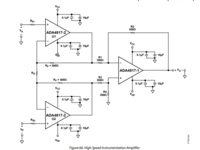Smillsey
Member level 5
Hi all
I am somewhat going round in circles here...
I need to design a differential measurement circuit to measure the voltage drop across a coaxial shunt which will have a frequency range of up to 10MHz.
Voltage across the shunt will be +/1V max (at lower frequency)
The common mode can be up to +/-50V
I was thinking about a differential amp based on the LT5400 and 3x ADA4817.
My rails will be +/-5V to the op amps
The shunt resistance is 10mOhms
I tried to simulate a 3 op amp instrumentation amplifier which failed - I will upload it shortly.
I want a 10V/V gain on this part of the circuit.
I tried to simulate a modified version of the ADA4817 datasheet, see attached.
But I just have an oscillator so i am missing something pretty obvious.... Any ideas?
I am somewhat going round in circles here...
I need to design a differential measurement circuit to measure the voltage drop across a coaxial shunt which will have a frequency range of up to 10MHz.
Voltage across the shunt will be +/1V max (at lower frequency)
The common mode can be up to +/-50V
I was thinking about a differential amp based on the LT5400 and 3x ADA4817.
My rails will be +/-5V to the op amps
The shunt resistance is 10mOhms
I tried to simulate a 3 op amp instrumentation amplifier which failed - I will upload it shortly.
I want a 10V/V gain on this part of the circuit.
I tried to simulate a modified version of the ADA4817 datasheet, see attached.
But I just have an oscillator so i am missing something pretty obvious.... Any ideas?




